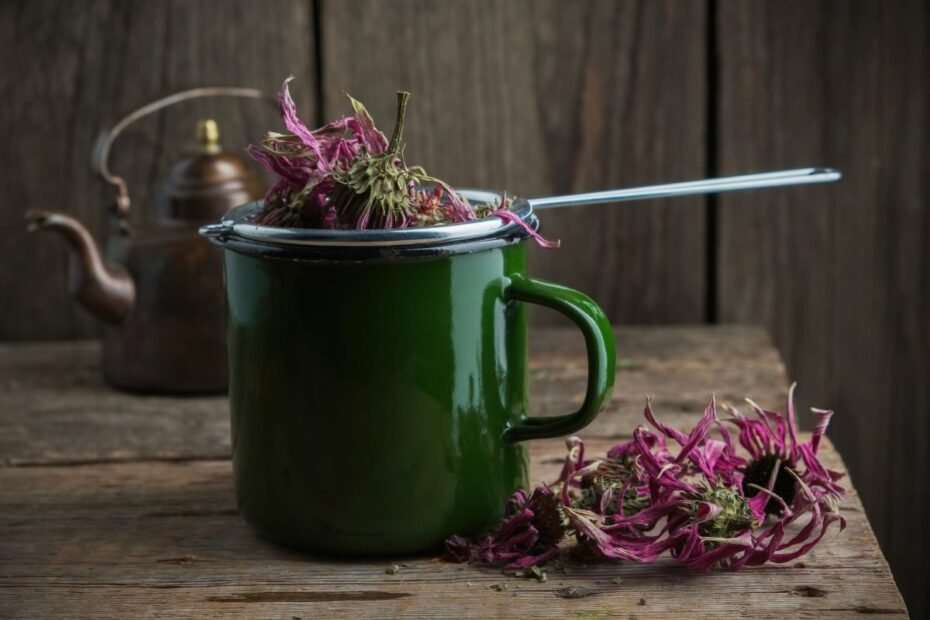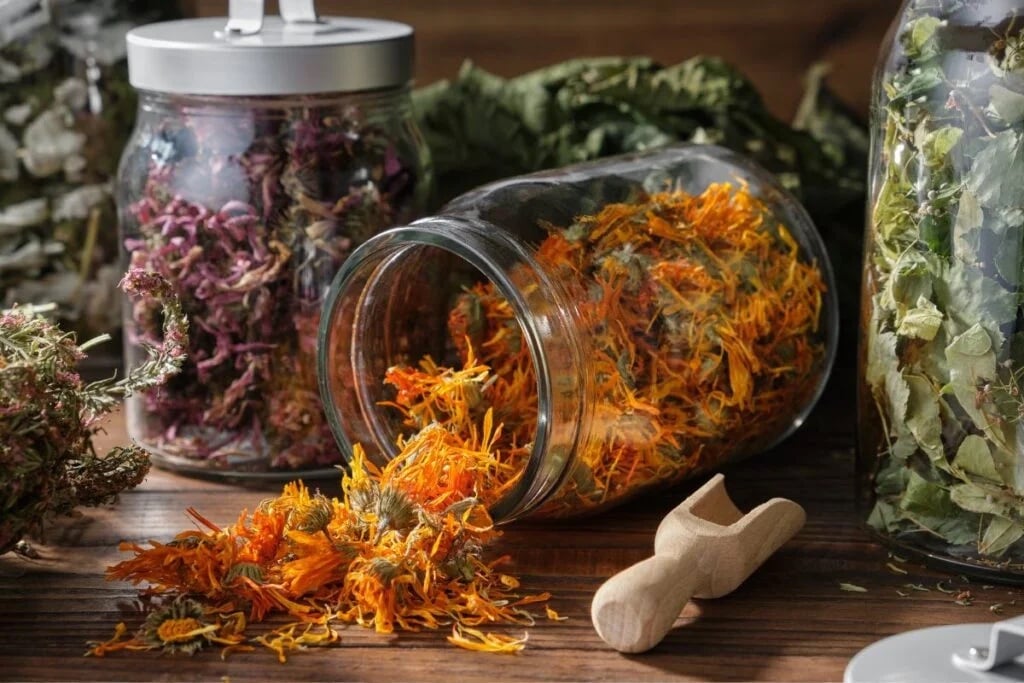Echinacea once grew abundantly on the banks of rivers in North America. People there know this plant as eastern purple coneflower, purple coneflower, and hedgehog coneflower and use it as a natural antibiotic. Native Americans weren’t only using this flower to make syrups, tinctures, and ointments, but also to prepare echinacea tea. They found echinacea tea benefits to heal wounds quickly and repair skin burn damage.
Echinacea is a perennial herbaceous plant about 20 cm tall, belonging to the Asteraceae family. The plant has a regular or branched top stem. The leaves are coarse, and the flowers are solitary. It flowers from mid-June to early September. Its fruits are husk-like. Echinacea is cultivated as a flower and a medicinal plant. There are two species of Echinacea, which people grow commonly: Echinacea angustifolia and Echinacea purpurea. The second one is used in herbal supplements and teas. The aerial plant parts and the roots are used for pills, tinctures, extracts, and tea production.
When and How to Harvest Echinacea Medicinal Raw Material
The most suitable echinacea for medicinal raw material is a pink-flowered one. The best-quality harvests of this echinacea come from 4-5-year-old plants. You can use the roots too when the plant grows 2–3 years.
Collect purple echinacea herb (stems, stems, and flowers) in July and August during its flowering season. You should harvest the part of the plant about 20–30 cm from the ground. It is recommended to collect echinacea herb on a sunny and dry day. You should dry echinacea grass in a well-ventilated room without direct sunlight. The ideal conditions for drying are between 40 and 45 degrees Celsius. The best storage for dried echinacea herb is in breathable bags. Dried echinacea retains its medicinal properties for up to 3 years. So long-term preservation of the herb may be ineffective.
The extracted echinacea roots should be well-washed and cut into pieces, then dried. Dry echinacea roots in the same way as echinacea herb. The most crucial factor is the right temperature (40–50 °C). At lower temperatures, the roots may start to mold. When the root breaks easily, it means that it has already dried. Store dried roots in a breathable bag in a dark place.
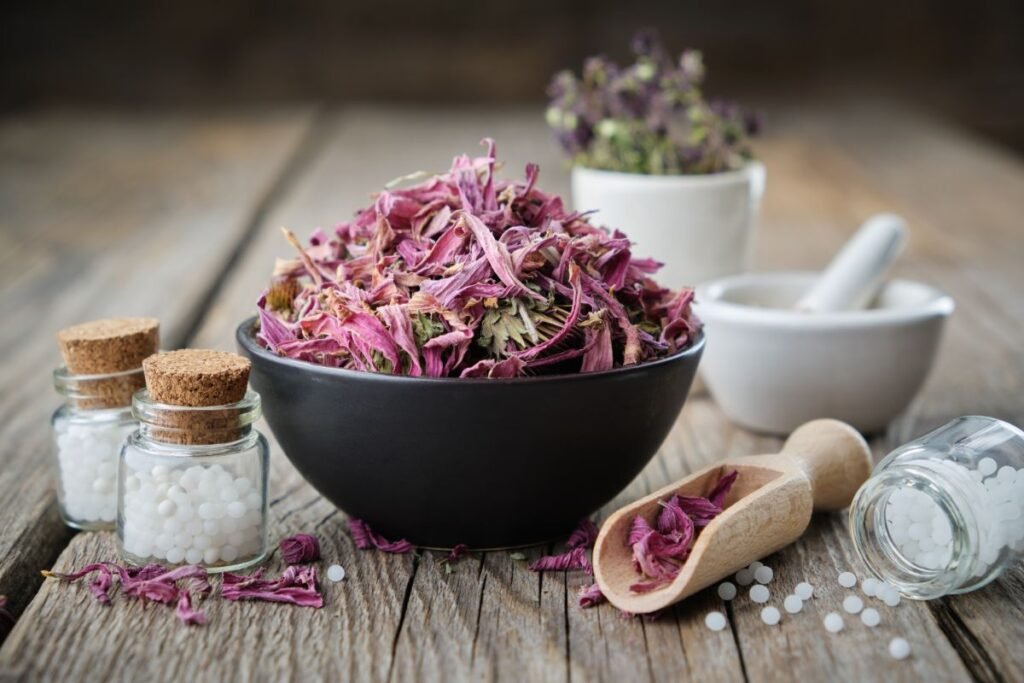
Echinacea Tea Benefits
Scientific studies have demonstrated echinacea as a significantly effective remedy for colds. Echinacea tea improves blood quality and enriches the body with beneficial trace elements. Cosmetologists also recommend this tea, claiming that echinacea strengthens hair and nail plates. In short, echinacea tea benefits include the solving of several health and beauty problems:
- improve blood clotting
- cleanse and normalize the lymphatic system
- improve the urinary tract and kidneys
- prevent bronchitis, acute respiratory infections, and pneumonia
- absorb toxins and remove them from the liver and other organs
- boost immunity
- reduce various inflammatory processes
The rich chemical profile of echinacea opens a wide range of benefits:
- antioxidants (they protect cells from oxidation, which is associated with chronic diseases)
- prebiotics (normalizing intestinal activity)
- organic acids (maintain acid-base balance)
- saponins (help in the treatment of urinary tract, respiratory, liver, and skin diseases)
- inorganic substances
Echinacea’s bottom parts contain essential oils, flavonoids, polysaccharides, oxycinnamic acids, saponins, tannins, organic acids, phytosterols, resins, echinacin, echinacoside, and polyamines.
The plant roots contain glucose, inulin, fat, essential oils, betaine, trace elements (silver, cobalt, manganese, selenium), and macronutrients (calcium, potassium).
Take echinacea tea for up to 1-2 weeks consecutively with a short break. For a healthy person, the daily portion is 1-2 cups, but during a cold or other infectious disease, the amount can be increased to 3 cups per day.
Echinacea Tea for Children and Pregnant Women
Echinacea tea is not recommended for pregnant and breastfeeding women. You shouldn’t give infants any teas or preparations containing echinacea. Children aged 2 years and over may take this herbal tea in moderation. 1 cup per week is the daily maximum dose for them.
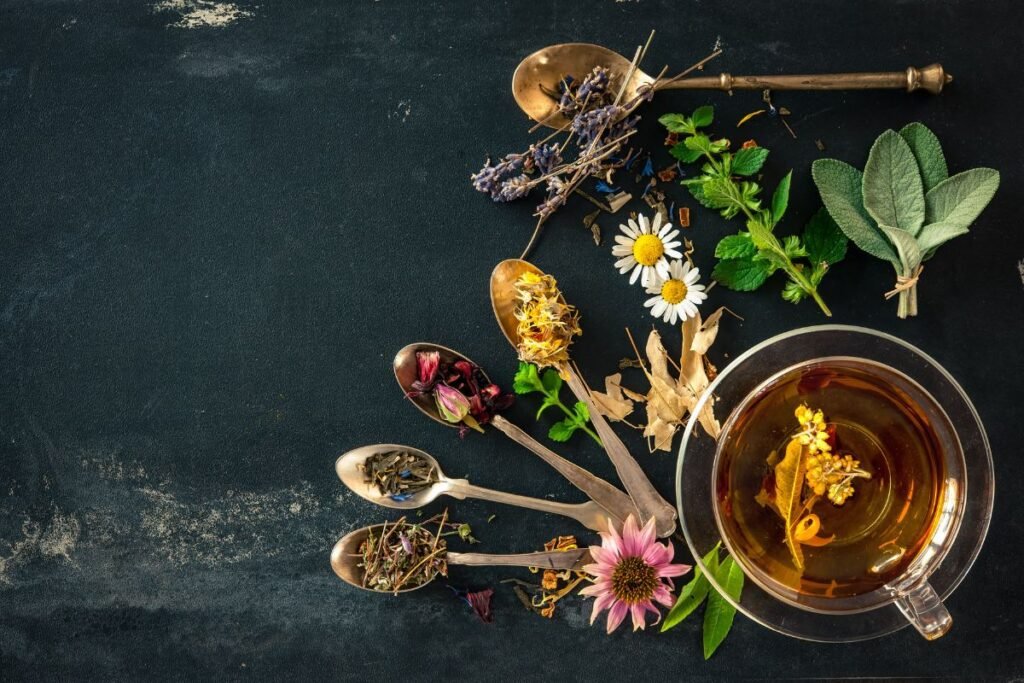
How to Make Echinacea Tea
You can make Echinacea tea or combine it with other herbs to add to its health-giving properties.
Echinacea Tea with Honey
Drink Echinacea tea two times a day before meals to support your immune system, to help you recover more quickly from colds, or simply as a preventative measure. Prepare echinacea tea in the usual, classic way.
You will need:
- 1-2 teaspoons of dried echinacea (both leaves and flowers are suitable)
- 200 ml of boiling water
- 1 teaspoon of honey
Cover the teaspoons with boiling water and leave them to steep for 10 minutes. When drinking this tea, the significant rule is to add it just before you drink it and after it has cooled slightly. The tea and the honey will retain their beneficial properties.
Echinacea and Linden Flower Tea
Echinacea and linden blossom tea are powerful combinations for colds. Lime blossom increases perspiration, which helps to reduce fever and increases the body’s resistance to infection. The drink also has sedative and antispasmodic effects. In addition, both plants are beneficial for the human immune system. If you would like to make this herbal tea, you will need the following:
- a thermos or similar heat-resistant container
- 500 ml of hot, boiled water
- 1 tablespoon of mixed dried echinacea flowers and leaves
- 1 tablespoon of dried lime blossom
Cover the teas with boiling water and leave for an hour. Strain the tea before drinking. Pour a little boiled water into the cup if the tea is too robust for you. Drink this tea up to 3 times a day.
Echinacea Root Tea
Try echinacea root tea to treat colds and respiratory illnesses and boost immunity. You need:
- a heat-resistant container
- 200-250 ml of water
- 1 tablespoon of dried echinacea root
Cover the roots with water and simmer for 15-20 minutes until boiling. When the water boils, turn off the heat. Boiling is not necessary to preserve as many healing properties as possible. Strain the tea into a cup and enjoy the Echinacea root tea.
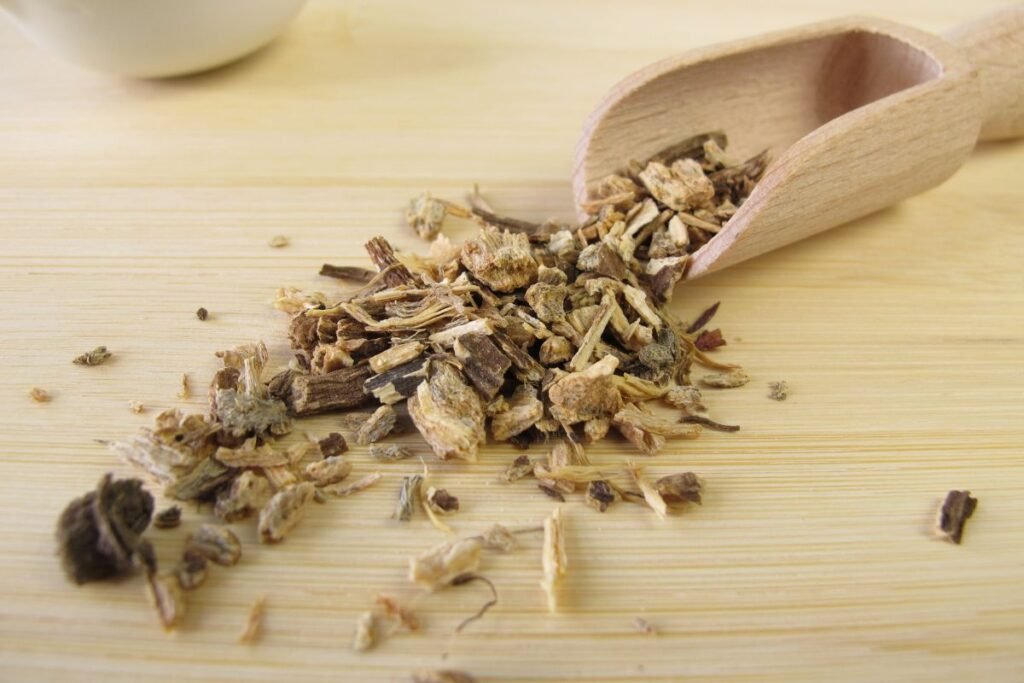
Echinacea Root Tincture
This alcoholic echinacea tincture is used for the prevention of viral diseases and to strengthen the immune system. You need:
- 500 ml of vodka
- 100 grams of dried echinacea roots
Pour the vodka over the dried echinacea roots and leave them in a dark place, such as a pantry or cupboard, for 2 weeks. It is essential to protect the tincture from direct sunlight. Stir the infusion periodically.
Take 20 drops three times a day for 12 days. Consult your doctor for advice on the use of the tincture.
This tincture can also be used for oily and acne-prone skin. Gently wipe clean and dry skin with cotton wool moistened with the tincture. Do not rinse. You can use this facial cleanser morning and night. Apply the tincture only to the affected areas and pimples. Apply a moisturizer after the treatment because alcohol dries the skin.
Echinacea Decoction for Hair
This decoction is suited for oily hair. Wash it over clean, damp hair. Do not rinse.
You need:
- a heat-resistant container that can be heated on the stove
- a metal bowl
- 1 tablespoon of echinacea flowers or leaves (crushed and dried)
- 200 ml of heated water
Place the echinacea in a bowl and cover it with boiling water. In a larger container, add water and heat to the stove. Place the bowl with the brewed herbs in the pot on the stove. When the water boils, leave the echinacea in the water ‘bath’ for another 15 minutes. Then, remove the bowl from the water and let it swell for half an hour. Strain the decoction when it has cooled, and increase the volume to 200 ml by adding boiled water.
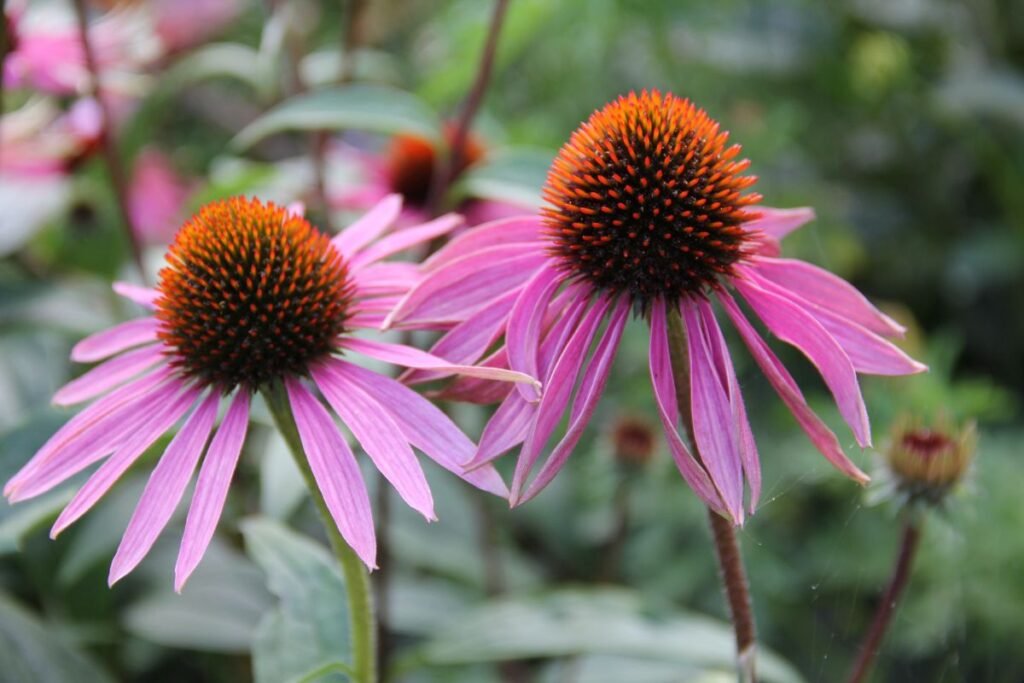
Echinacea Tea Side Effects
Drinking concentrated echinacea teas in large quantities or taking preparations containing echinacea in large doses may cause dizziness, tremors, nausea, diarrhea, or vomiting.
People taking immunosuppressive drugs (immunosuppressants) should not take echinacea, as it may weaken the activity of the medications. This also applies to people suffering from tuberculosis, leukemia, diabetes, HIV, AIDS, or any autoimmune disease. This herb should also not be used by people who have had organ transplants.
Although rare, echinacea can cause allergic reactions. Reactions can be mild, but sometimes echinacea can cause anaphylaxis (breathing problems), especially for people with asthma. It is also not suitable for people allergic to the Asteraceae family.
Be sure to check with your doctor before taking echinacea tea or supplements containing echinacea.
Sources:
- https://www.ncbi.nlm.nih.gov/pmc/articles/PMC8850513/
- https://www.sciencedirect.com/science/article/abs/pii/S0965229918312585
Associative photos from © Canva.
